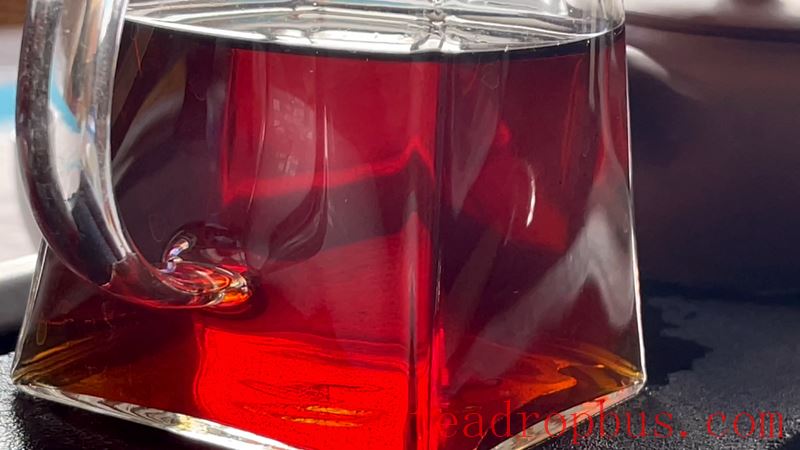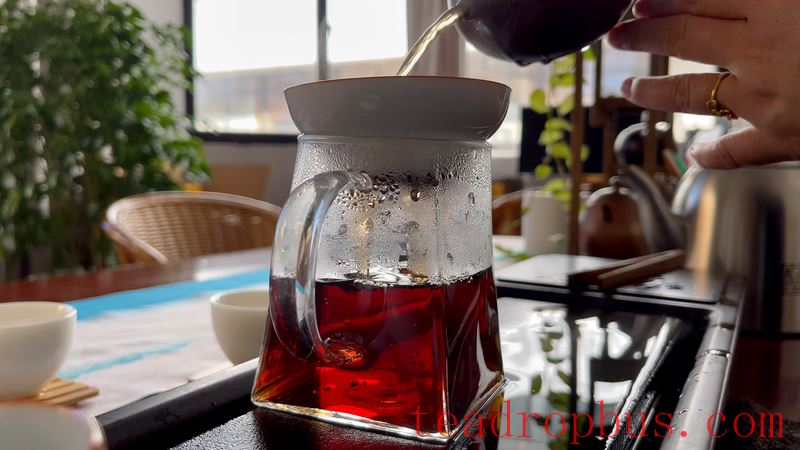When brewing Pu'er ripe Tea, it is recommended to use a purple clay pot or a Gaiwan. Purple clay pots have good breathability and adsorption properties, which can make the tea soup smoother. For lower-grade raw materials or older-aged ripe teas, a purple clay pot is recommended. A gaiwan cools down quickly, making it convenient for temperature control when pouring out the infusion. When adding water, pour steadily while maintaining high water temperature to fully stimulate the aged aroma of the ripe tea. You can pour from high or low, focus on a point or swirl the water, extending the Steeping time to ensure the tea leaves are sufficiently soaked, allowing the tea essence to fully seep out.

How should ripe tea be brewed?
1. Preparing the tea: Control the tea-to-water ratio to establish the foundation for the strength of the brew.
For a 110 ml gaiwan, use 7 grams of tea. This amount of tea generally ensures a well-balanced ratio. Adjust according to personal taste. Also adjust the brewing time per infusion accordingly. For example, if you want more infusions, increase the amount of tea and try to pour out the water quickly in the first few infusions.
2. Washing the tea: Moisturize the tea leaves and clean the surface of the leaves.
Starting with washing the tea, pour water gently. You can swirl or pour in a thin stream, but the water flow must be calm and steady. Do not cause the tea leaves to move violently. If you wash twice, the first rinse can use a slightly higher pouring point, with a fine water stream, lowering the water temperature for washing. The second rinse can use a slightly lower pouring point, with higher water temperature. After washing, try to thoroughly drain the tea leaves.
During the washing process, warming the cups is generally required. However, since washing the tea involves cleaning, it is not advisable to use the rinsed tea water to warm the cups. I personally recommend using boiling water directly from the kettle to warm the cups. Visually and practically, this is cleaner.

3. First three infusions: Suppress off-flavors and improve the mouthfeel.
Basic method: Pour slowly into a single spot. Slowly infuse the water to minimize the relative movement between the water and tea. When you pour slowly enough, you will notice that the color of the water in the gaiwan is very light, unlike when pouring vigorously, which would stir up the reddish-brown tea soup and even the tea residue.
When pouring out the tea, it is suggested to use a fair cup. This allows the colors and flavor substances to recombine in the fair cup, and you will find that the tea soup extracted by slowly pouring water is soft and viscous, but has little aroma.
After each infusion, it is recommended to completely drain the tea leaves. Leaving some tea in the leaves may increase the number of infusions, but it changes the rhythm and balance of flavor substance extraction, introducing a lot of instability to the brewing process.
5. Middle three to five infusions: Aromas and flavors blend harmoniously.
Basic method: Slowly swirl the water and pour steadily. Avoid vigorous pouring. The water temperature and the relative movement between water and tea need to be controlled at a reasonable level so we can balance aroma and flavor, achieving harmony.

Slow swirling sounds simple, but in practice, it is quite technical. In actual brewing, how to swirl, how fast, how thick the water column, how high the pouring point—all these need to be adjusted by the tea brewer based on the nature of the tea and the taste preferences of the drinkers.
6. Last three infusions: High aroma, smooth mouthfeel, sweet and mild taste.
Basic method: Pour water quickly, keeping the tea leaves at a consistently high temperature. Pouring can be high or low, focused on a point or swirling the water. What's important is stirring the tea leaves and maintaining high water temperature to fully stimulate the aged aroma.
7. Throughout the entire brewing process, do not shake, stir, or disturb the tea leaves.
Doing so will make the tea soup murky and may make the tea flavor thin and the water taste prominent. Similarly, keep the pouring steady. Even when pouring from high, maintain a calm and smooth water column.